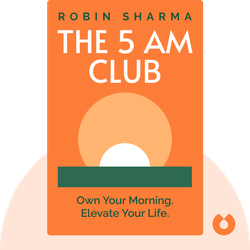Try Blinkist to get the key ideas from 7,000+ bestselling nonfiction titles and podcasts. Listen or read in just 15 minutes.
Start your free trial
Blink 3 of 8 - The 5 AM Club
by Robin Sharma

How Imitation Sparks Innovation
'The Knockoff Economy' by Kal Raustiala and Christopher Sprigman is a book that explores the world of imitative products and how they exist in a separate legal and cultural realm. It explores the implications of knockoff products for innovation and creativity in the global economy.
In any discussion on copyright law, you’ll often hear that copying and imitation damage creativity and innovation. People believe that copying is cheaper than creating, which in turn reduces the incentive to innovate. After all, why spend all your time and money coming up with the best idea if you could just copy it instead?
But the industries that are the most creative are not even protected by copyright laws. Copying is simply a matter of course in fashion, and yet the industry thrives nevertheless.
In fact, data from the US Bureau of Labor shows that, from 1998 to 2012, the average price of garments has remained virtually unchanged. The companies whose goods are often copied produce the highest priced garments, and one might think that copying would hurt their bottom line. In reality, these brands flourish, despite selling their garments at 250 percent the price of the copying competition.
In the same vein, there is no copyright protection for recipes. Despite this, many believe the culinary world is at a creative peak.
If you are a chef whose prized recipe is copied, your reputation as an inventive cook is burnished. Thomas Keller’s dish “Oyster and Pearls,” for example, has been widely copied. Did it run him out of business? No. In fact, it brought Keller’s restaurant The French Laundry – and Keller himself – international recognition and success.
Furthermore, industries that promote strict copyright laws are not necessarily more creative. Industries such as music and film, which have more stringent protections against copying, have actually been experiencing a decline in their markets. These protections, rather than simply hindering pirating, can make it harder for new competitors who could have been at the forefront of innovation in the field to freely sample existing work in their own creations.
Obviously there are industries where copying is prevalent, and they are nonetheless creative, but in some areas copying is part of the creative culture.



The Knockoff Economy challenges the idea that copying and imitation pose serious barriers for industries. Instead, it uses concrete examples to demonstrate how, in an age where copying is easier than ever before, innovation is at its historical zenith.
The Knockoff Economy (2012) explores the fascinating world of imitation and counterfeiting, shedding light on the industries and individuals that thrive on copying. Here's why this book is worth reading:
For a celebrity chef, cooking means handing someone a recipe. – Chef Bobby Flay

It's highly addictive to get core insights on personally relevant topics without repetition or triviality. Added to that the apps ability to suggest kindred interests opens up a foundation of knowledge.
Great app. Good selection of book summaries you can read or listen to while commuting. Instead of scrolling through your social media news feed, this is a much better way to spend your spare time in my opinion.
Life changing. The concept of being able to grasp a book's main point in such a short time truly opens multiple opportunities to grow every area of your life at a faster rate.
Great app. Addicting. Perfect for wait times, morning coffee, evening before bed. Extremely well written, thorough, easy to use.
Try Blinkist to get the key ideas from 7,000+ bestselling nonfiction titles and podcasts. Listen or read in just 15 minutes.
Start your free trial
Blink 3 of 8 - The 5 AM Club
by Robin Sharma
What is the main message of The Knockoff Economy?
The main message of The Knockoff Economy is that imitation can drive innovation and creativity.
How long does it take to read The Knockoff Economy?
The reading time for The Knockoff Economy varies, but it typically takes a few hours. The Blinkist summary can be read in just 15 minutes.
Is The Knockoff Economy a good book? Is it worth reading?
The Knockoff Economy is worth reading because it explores how imitating and copying can lead to innovation and economic growth.
Who is the author of The Knockoff Economy?
The authors of The Knockoff Economy are Kal Raustiala and Christopher Sprigman.